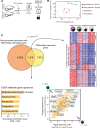Aging imparts cell-autonomous dysfunction to regulatory T cells during recovery from influenza pneumonia
- PMID: 33600379
- PMCID: PMC8026188
- DOI: 10.1172/jci.insight.141690
Aging imparts cell-autonomous dysfunction to regulatory T cells during recovery from influenza pneumonia
Abstract
Regulatory T (Treg) cells orchestrate resolution and repair of acute lung inflammation and injury after viral pneumonia. Compared with younger patients, older individuals experience impaired recovery and worse clinical outcomes after severe viral infections, including influenza and SARS coronavirus 2 (SARS-CoV-2). Whether age is a key determinant of Treg cell prorepair function after lung injury remains unknown. Here, we showed that aging results in a cell-autonomous impairment of reparative Treg cell function after experimental influenza pneumonia. Transcriptional and DNA methylation profiling of sorted Treg cells provided insight into the mechanisms underlying their age-related dysfunction, with Treg cells from aged mice demonstrating both loss of reparative programs and gain of maladaptive programs. Strategies to restore youthful Treg cell functional programs could be leveraged as therapies to improve outcomes among older individuals with severe viral pneumonia.
Keywords: Aging; T cells.
Conflict of interest statement
Figures










References
-
- Thompson WW, et al. Epidemiology of seasonal influenza: use of surveillance data and statistical models to estimate the burden of disease. J Infect Dis. 2006;194 suppl 2:S82–S91. - PubMed
Publication types
MeSH terms
Grants and funding
LinkOut - more resources
Full Text Sources
Other Literature Sources
Medical
Molecular Biology Databases
Miscellaneous

